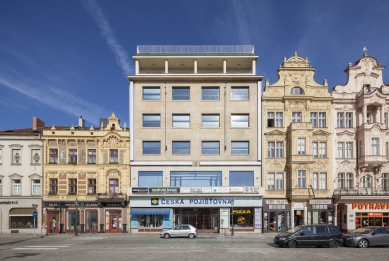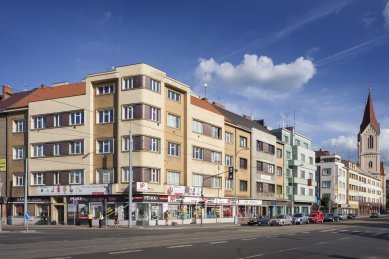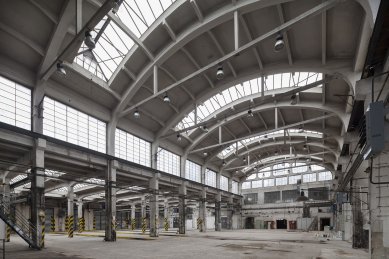
Plzeň Architectural Manual (PAM): Paths through Architecture 1914–1948
Source
Zuzana Bednářová, Pěstuj prostor, z.s.
Zuzana Bednářová, Pěstuj prostor, z.s.
Publisher
Tisková zpráva
15.02.2022 14:45
Tisková zpráva
15.02.2022 14:45
Czech Republic
Pilsen
After seven years since the first exhibition of the PAM project in the newly opened cultural zone DEPO2015, the Plzeň Architectural Manual will remind the local public of its presence with an exhibition in the public space in front of the Study and Research Library of the Plzeň Region in Smetanovy Sady in Plzeň. The exhibition on large-format panels will present 18 trails covering the architecture and building culture of the city from 1914 to 1948, complemented by a partial probe into the numerous public spaces and architects included in the project's online database. The exhibition will run until March 8, 2022.
title: Plzeň Architectural Manual (PAM): Trails through Architecture 1914–1948
duration: February 18 – March 8, 2022
opening: February 17, 2022, at 5 PM location: Smetanovy Sady in front of the Study and Research Library of the Plzeň Region, Plzeň
curator: Petr Klíma
organizing organization: Pěstuj prostor, z. s.
web: pam.plzne.cz
The Plzeň Architectural Manual (PAM) project has been mapping the architecture and building culture of the city since 2014, focusing on periods roughly defined by the years 1914–1948 and 1948–1989. The project's aim, inspired by the successful Brno Architectural Manual (BAM), is to present Plzeň's architecture in its natural environment, to "exhibit" it in the streets and public spaces of the city. Therefore, individual buildings in the online database, available at pam.plzne.cz, are organized into trails that traverse most of the city's districts and significant locations.
“The Plzeň architecture of the years 1914–1948 is currently covered by 18 trails. Besides buildings and parts of the city, we want to bring the architects, builders, and public spaces closer to the project, not only through the online database, but also through audio recordings and printed publications. All this will be available in Czech, English, and gradually in German,” states the curator of the exhibition from the organizing association, Petr Klíma.
The database of architecture from this period contains hundreds of objects and building collections presented not only through texts but also through several thousand contemporary photographs, reproductions of original drawings, and other archival materials. All buildings are also accompanied by dating, address, GPS coordinates, and information about the nearest public transport stops. The database includes over 100 architects and builders and also 50 public spaces, some of which document not only the necessary texts but also authorial drawings. An integral part of the project's web interface is an interactive map of Plzeň.
Although a substantial portion of the buildings, architects, and builders active between 1914 and 1948 has already been published online, work on supplementing the database – especially for trails C10–C18 – is ongoing. This applies particularly to individual objects and their authors, but the authors do not rule out additions to whole trails either. “For the exhibition, we dedicate one panel to each of the trails with a short introductory text and contemporary photographs of several selected buildings. On the remaining two panels, we present a similar sample of architects who significantly influenced the face of interwar Plzeň, and half a dozen public spaces,” describes the exhibition's content Petr Klíma.
To ensure that the public recognizes the architectural and urban values of the city, in addition to the database and other outputs of the PAM project, guided walks are also organized each year from spring to autumn (often as part of the Industry Open festival, the Festival of Freedom, European Neighbors' Day, or the Celebrations of the Republic's Founding) and generally follow the routes of the individual trails. “Indeed, the mediation of the experience with architecture exhibited in situ, architecture about itself, remains the main goal of the project,” adds Petr Klíma. The exhibition is being held with significant financial support from the Ministry of Culture of the Czech Republic and with the support of the statutory city of Plzeň.
title: Plzeň Architectural Manual (PAM): Trails through Architecture 1914–1948
duration: February 18 – March 8, 2022
opening: February 17, 2022, at 5 PM location: Smetanovy Sady in front of the Study and Research Library of the Plzeň Region, Plzeň
curator: Petr Klíma
organizing organization: Pěstuj prostor, z. s.
web: pam.plzne.cz
The Plzeň Architectural Manual (PAM) project has been mapping the architecture and building culture of the city since 2014, focusing on periods roughly defined by the years 1914–1948 and 1948–1989. The project's aim, inspired by the successful Brno Architectural Manual (BAM), is to present Plzeň's architecture in its natural environment, to "exhibit" it in the streets and public spaces of the city. Therefore, individual buildings in the online database, available at pam.plzne.cz, are organized into trails that traverse most of the city's districts and significant locations.
“The Plzeň architecture of the years 1914–1948 is currently covered by 18 trails. Besides buildings and parts of the city, we want to bring the architects, builders, and public spaces closer to the project, not only through the online database, but also through audio recordings and printed publications. All this will be available in Czech, English, and gradually in German,” states the curator of the exhibition from the organizing association, Petr Klíma.
The database of architecture from this period contains hundreds of objects and building collections presented not only through texts but also through several thousand contemporary photographs, reproductions of original drawings, and other archival materials. All buildings are also accompanied by dating, address, GPS coordinates, and information about the nearest public transport stops. The database includes over 100 architects and builders and also 50 public spaces, some of which document not only the necessary texts but also authorial drawings. An integral part of the project's web interface is an interactive map of Plzeň.
Although a substantial portion of the buildings, architects, and builders active between 1914 and 1948 has already been published online, work on supplementing the database – especially for trails C10–C18 – is ongoing. This applies particularly to individual objects and their authors, but the authors do not rule out additions to whole trails either. “For the exhibition, we dedicate one panel to each of the trails with a short introductory text and contemporary photographs of several selected buildings. On the remaining two panels, we present a similar sample of architects who significantly influenced the face of interwar Plzeň, and half a dozen public spaces,” describes the exhibition's content Petr Klíma.
To ensure that the public recognizes the architectural and urban values of the city, in addition to the database and other outputs of the PAM project, guided walks are also organized each year from spring to autumn (often as part of the Industry Open festival, the Festival of Freedom, European Neighbors' Day, or the Celebrations of the Republic's Founding) and generally follow the routes of the individual trails. “Indeed, the mediation of the experience with architecture exhibited in situ, architecture about itself, remains the main goal of the project,” adds Petr Klíma. The exhibition is being held with significant financial support from the Ministry of Culture of the Czech Republic and with the support of the statutory city of Plzeň.
The English translation is powered by AI tool. Switch to Czech to view the original text source.



0 comments
add comment










